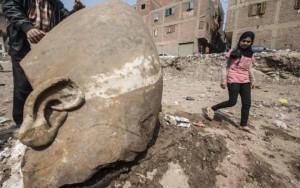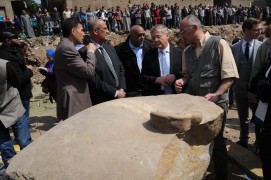كتب صحيفة التايمز الدولية
IBRAHIM SHEHATA
The Egyptian German archaeological mission continues its work at the Souq Al-Khamis district in Al-Matareya area, Ain Shams to lift the
second part of the newly discovered colossus possibly of king Ramses II from its pits. The colossus was carved in quartzite and found in parts in the vicinity of King Ramses II temple in ancient Heliopolis (Oun)Sun Temples by a German-Egyptian archaeological mission.
Minister of Antiquities Dr. Khaled El-Enany is to witness today’s event..
Dr. Mahmoud Afifi, Head of the Ancient Egyptian Antiquities at the Ministry said that the first part of the statue was lifted out of its pit last Thursday. This part weights almost 3 tones and includes of a large part of the king’s crown, right ear and a part of the right eye.
Dr. Aymen Ashmawy, Head of the Egyptian team describes the discovery as “very important” because it shows that Oun Sun temple was enormous with magnificent structure, distinguished engravings, soaring colossi and obelisks.
Dr. Dietrich Raue, head of the German mission said that Oun Sun Temple was subjected to damages during the Greaco-Roman time and early Coptic time as most of its obelisks and colossi were transported to Alexandria and Europe. During the Islamic era, the blocks of the temple were used in the construction of Historic Cairo.
Dr. Ashmawy said that the mission is working hard to lift-up the newly discovered statues to be transported to the Matariya obelisk archaeological site for restoration. More excavation works to search for other statues and artefacts are taking place to reveal more of the city secrets.
Dr. Tarek Tawfik, Supervisor General of the Grand Egyptian Museum (GEM) said that after lifting up the second part of the statue, it would be transported to the Egyptian Museum in Tahrir for restoration and temporary exhibition in order to put on display within the GEM displaying Scenario.
Dr. Afifi explains that latest preparations were carried out yesterday by the German Egyptian research team to lift up the second part of thestatue.
They reinforced the part of the statue which is going to be pulled out of the pit, by bedded ropes especially used with heavy antiquities after measuring its approximate weight and dimensions.
On his part Eissa Zidan Head of First Aid Conservation in GEM, pointed that the team extracted a sample from the water damp where the statue is lying on to implement the required analysis in situ. The test reported that the water is neutral to simply alkaline. A complete compounds analysis of the water would be carried out.
Meanwhile the part of the statue pulled out on Thursday is completely packed by treated materials to develop a gradual adaptation through wetting it with neutral water and perforating it to react gradually with its new environment.







